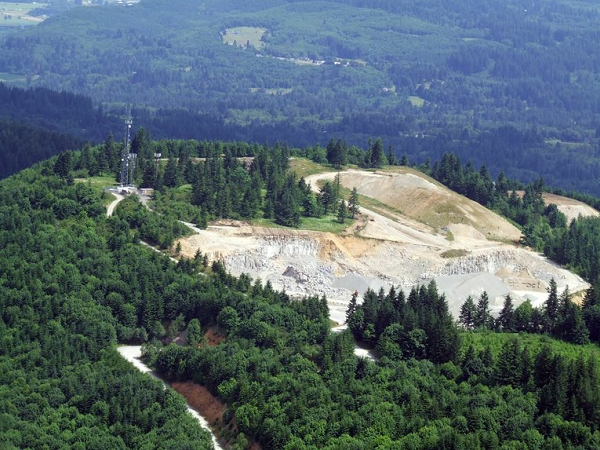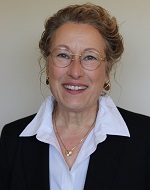Apply now to join our next cohort of Community Science Fellows and Community Leads!

Yacolt Mountain Quarry Aerial View, Photo by The Columbian
The East Fork Community Coalition, led by Dick Leeuwenburg and Marie Ogier, teamed up with AGU scientists to evaluate potential risks associated with the proposed expansion of the Yacolt Mountain Quarry. The resulting output for this first phase of an ongoing project included compiling evidence-based recommendations to include in a package submitted to Clark County on behalf of EFCC to ensure the safety of residents in the area of quarry. In response to the concerns outlined in the “Description Section,” the items below contributed toward ongoing efforts of the EFCC.
Questions and recommendations related to the above topics was submitted to the county in early 2021. Future work on this project may include completing full assessments on the ground to evaluate potential risk to community members in more detail and ensure families in the area stay safe.
Clark County is a county in the southwest corner of Washington State with the Columbia River defining its southern and western borders. Outside of its most populous area of Vancouver, WA, majority of the county is rural and forested. Nested between the Cascade Mountains and the Pacific Coast, the East Fork of the Lewis River, a tributary to the Columbia, cuts through the northern part of the county and provides cold water habitat for endangered Pacific salmonids. Community members describe their home as beautiful and note that their rural lifestyle provides both privacy, a quiet retreat, and endless opportunities for outdoor recreation.
Over the past five years, community members have voiced concerns about the environmental and health impacts from nearby Yacolt Mountain Quarry, where volcanic rock is mined and crushed into gravel and other aggregate. Approximately 1,300 homes are located within 2 miles of the quarry and have complained of loud blasts rattling their homes. Dust and noise generated from the mining operations and truck travel disturbs residents on a daily basis. Residents are also concerned about the impact of the mining on the local aquifer which supplies drinking water and the health of critical salmonid streams. There is a general concern about the impact of the mining operations on drinking water supplies. Dust settles out in people’s homes and there is increased concern over the risk of landslides from the operations. The 2014 mudslide that killed 43 people in Oso, WA remains fresh in people’s memories.
In December 2018, the Clark County Council approved the expansion of the mine to the south to store overburden. Concerns over the quarry’s impacts have only deepened and residents have organized to focus more attention on the issue. An analysis of dust collected inside a home in Battle Ground, WA found dust particles with characteristics similar to Woolly Erionite, a naturally occurring asbestos. When airborne, Woolly Erionite can be inhaled where the fibers become lodged in the lungs, causing respiratory, cardiovascular and increased cancer risk. Residents are concerned that the Woolly Erionite may be associated with the mining activity.
The recently established East Fork Community Coalition (EFCC) is dedicated to protecting families and homes along the East Fork of the Lewis River. They do this by sharing information and communicating concerns about issues facing the area. EFCC’s goal for this project is to gain new information about the impacts that the Quarry is having on the environment and residents in the area. This includes understanding the composition and source of the dust that settles out, how the dust is generated, the risks of continued mining to drinking water, and the potential for landslides.
The first priority for this project will be to engage with a scientist to further understand the composition and source of the dust. Other priorities will addressed in later phases of the project.
Project Impacts: Beneficiaries include community members of all ages who reside near the quarry as well as the natural resources and assets across the landscape. Health risks will be lowered, and the expectation is that the community will know how to mitigate exposure to any risks that the quarry operations may pose. By bringing the community together around a common goal, the community leaders will be able to bring the needs of this community to the forefront of policy- and decision-makers.
Project Outputs:
Outputs include:
Nestled between the Cascade Mountains and the Pacific Coast, Clark County, Washington, is a largely rural, forested area rich in both natural beauty and natural resources. Outdoor enthusiasts are drawn to the sweeping river views and bountiful fishing afforded by the Columbia and Lewis Rivers, while industrial interests are drawn by the region’s stores of volcanic rock, which has been mined and crushed into gravel and other aggregates in the Yacolt Mountain Quarry since 2002.
Mining is seen as important to the region’s economy, yet residents worry about its impacts on the environment, their health and their quality of life. Some residents contend that the county hasn’t had adequate staff to enforce environmental compliance, and suspect the dust and silt it generates are contributing harmful pollutants to the air and groundwater. The increased mining activities have also brought noise and light to this formerly peaceful area and raised the risk of landslides and driving hazards associated with big trucks on small roads.
Now, a proposed expansion of the quarry has brought tensions to a head. In the face of this development, the East Fork Community Coalition (EFCC), a grassroots group of residents on the East Fork of the Lewis River, is partnering with scientists to understand the environmental impacts of the mining activities—and push back to protect the place they love.
We spoke with Marie Ogier, EFCC Secretary, about why her group is so dedicated to their mission.
How would you describe Clark County to someone who has never been there?
It’s absolutely beautiful. We’re north of Portland, Oregon, just across the Columbia River, and a lot of people come to the East Fork for recreation. It’s an easy day trip. We took our kids when they were young—that was where you hung out on a hot summer day. It has parks, wineries…it’s just a beautiful area.
What do you see as the unique strengths of Clark County and its community members?
It’s a really pretty area that draws a lot of people who want to protect it. The EFCC is mostly retired professionals who have lived here for many years and have very strong convictions about protecting the environment and the people that live here. We’re all devoting a lot of personal time to this because of our strong conviction that this [work] needs to be done.
What do you see as its unique or surprising challenges?
The county is really struggling, and sees aggregate industry growth as a path forward economically. The struggles mean they don’t have staff to enforce their own permits. After pressure from several groups, they finally hired code enforcement officers, but they only have two for the entire county. The people that would normally protect the public are overwhelmed. They’re not bad people; they are just stretched too thin.
There’s also a real chasm between our group and other viewpoints. People are being told that we’re going after their livelihoods, and we are not. My husband worked for a mining equipment company for 35 years! We’re not against industry, growth or development, but we want this specific quarry to be brought into compliance for the protection of this river and the people living here.
What do you think people would be surprised to learn about your community?
It’s a documented landslide area on both sides. Below this quarry is the river, home sites, wineries and other businesses that are destination spots. Also at the base of this quarry is a wild gene bank of steelhead and four threatened or endangered salmonid species, treasures that the county has spent more than $23 million to restore.
What advice would you give other groups seeking to solve a community problem?
My advice is to find other organizations—like Catchafire, Patagonia Action Works, or Taproot Foundation—that can teach you how to be effective, especially social-media wise. Catchafire helped us find three pro bono web designers so we could educate the public with the scientific data gained by our scientist contacts at Thriving Earth Exchange. Knowing what steps to take so volunteers can be more efficient is so important. A network of other people who have done grassroots activism can help, especially when we are all doing this in our spare time.
What do you see as priorities to help ensure your community is a great place to live 20 years from now?
At this moment, it’s terrible. The roads are dangerous from the gravel trucks that cause accidents and speed, and the crusher is loud and throws off dust that travels for miles. The blasts are so loud, and happen before and after permitted hours. People are terrified even from 2 miles away. One of the farms nearby said their customers panic when a blast goes off. There is rock, sand and debris coming down so hard they have to go indoors. Children wait for school buses on winding, narrow quarry roads.
The peaceful livability of this valley is being destroyed, and it is just such a beautiful area. I wish you could see the moss on the trees, the views of the river and the falls. We all feel so strongly that people need to step forward to help protect this area. The quarry wants to more than double. They just bought 560 acres, and this isn’t going away unless we stop it. It’s an accident waiting to happen in so many ways. We don’t want the people to be lost, and we don’t want this river to be lost. There’s not that many of them left!
Community Leaders

Dick Leeuwenburg is the president and founding member of the East Fork Community Coalition (EFCC). He has a BS in Industrial Engineering from Stanford University and an MBA from the University of Chicago. Work experience includes a stint as an economist for an international oil company and CEO of a publicly traded corporation. Dick and his wife , Jann, have lived on 35 acres in the valley of the East Fork of the Lewis River for 25 years.

Marie Ogier is the Secretary for EFCC and a former Sales Executive, training sales personnel in business, networking, and management. She has served on the Board for 3 regional non-profits specializing in fundraising, sponsorship, and advocating. As a Community Volunteer and Master Gardener she enjoys collaborating with others for a safe and healthy environment. Living with her husband, Gary, in Clark Co for 31 years, she respects and appreciates the irreplaceable asset of the East Fork of the Lewis River. She is also a founding member of East Fork Community Coalition.
Science Liaison
Dr. Alyssa Shiel is an Assistant Professor in Geology & Geophysics at Oregon State University. She studies heavy stable isotope geochemistry and the environmental fate of metals/metalloids. Bio coming soon!
(c) 2024 Thriving Earth Exchange